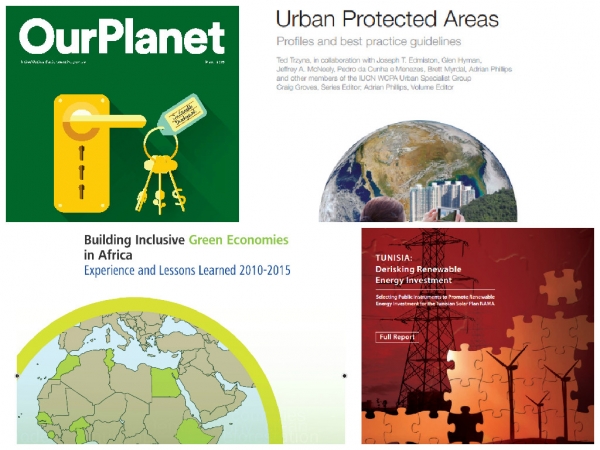New publicactions on urban protected areas, renewable energy, global actions and green economy

Here all of them:
(1) Tunisia: Derisking Renewable Energy Investment
This new report presents the results of an innovative modelling analysis on the cost effectiveness of public interventions to promote private sector investment in renewable energy. The report quantifies how risk categories are currently contributing to higher financing costs for renewable energy in Tunisia, and how policymakers can put together public instrument packages which systematically target these risks and lower financing costs. The report estimates that public derisking instruments can catalyse EUR 2.8 billion in private sector investment, and create savings for Tunisia of EUR 712 million (large-scale wind energy) and EUR 359 million (large-scale solar PV) over 20 years. One of the report’s key findings is that investing upfront in derisking measures is far more cost effective than paying a tariff-based price premium to compensate for risks.
This analysis has been performed as part of UNDP’s support to the Government of Tunisia, under a project financed by the Global Environment Facility (GEF). The project is supporting the development of a NAMA for the Tunisian Solar Plan, Tunisia’s official long-term plan for renewable energy. This Tunisia analysis represents the first application of the derisking modelling approach for the design of a NAMA (estimating total private sector investment, the selection and cost of public interventions, and anticipated GHG reductions).
- The following materials, in both English and French, are available for download HERE
(2) Urban Protected Areas: Profiles and Best Practice Guidelines
Best Practice Protected Area Guidelines Series No. 22.
This book is divided in three parts:
• Part 1, Urban protected areas – context and concept, provides a brief context to the growing interest in urban protected areas and then explains what urban protected areas are, why they matter and how they are distinctive.
• Part 2, Profiles of urban protected areas, describes protected areas in 15 metropolitan areas around the world.
• Part 3, Best practice guidelines, is organized into four sections: protected areas and people; protected areas and places; protected areas and institutions; and the creation, promotion and improvement of urban protected areas. The guidelines are illustrated by references to examples taken from the 15 profiles, as well as from other locations. As far as possible, a global perspective has been taken but inevitably some countries figure more in the range of examples than others.
It is designed primarily for managers of urban protected areas and those responsible for protected area systems, but it has been written in non-technical language with a broader readership in mind.
- The publication is available for download HERE
http://www.iucn.org/about/union/secretariat/offices/usa/?14829/Urban-Protected-Areas---Profiles-and-best-practice-guidelines
(3) Our Planet: Time for Global Action
As we move towards the historic post-2015 summit at the 70th UN General Assembly next September, governments will be expected to adopt a transformational sustainable development agenda, including the finalization of the Sustainable Development Goals. This issue of Our Planet emphasizes the importance of an integrated and universal approach to the Sustainable Development Goals and the post-2015 agenda. The SDGs are based on three principles: 1) leaving no-one behind (in terms of poverty alleviation and development); 2) ensuring equity and dignity for all; 3) achieving prosperity within the Earth's safe and restored operating space. Our Planet also carries articles from leading authors on the post-2015 sustainable development agenda, as well as highlighting relevant work that UNEP has been carrying out in relation to the SDGs.
- The publication is available for download HERE
(4) Building Inclusive Green Economies in Africa - Experience and Lessons Learned 2010-2015
This synthesis report provides an overview of where Africa, as a region, stands in terms of transitioning to an inclusive green economy. It draws on recent studies to summarise the prospective gains and challenges associated with investing in a green economy and outlines a way forward to prioritise policy reforms, with a specific section on how to turn strategies and practices challenges into opportunities. Collectively, this report highlights how a transition to a green economy may be achieved within a range of country conditions.
- The publication is available for download HERE

Facebook comments